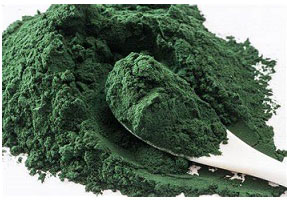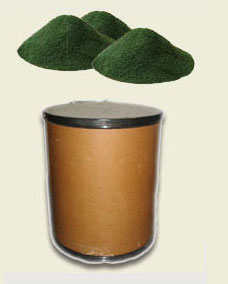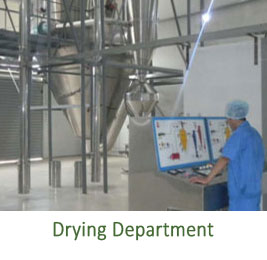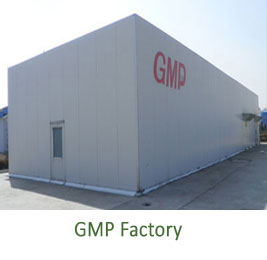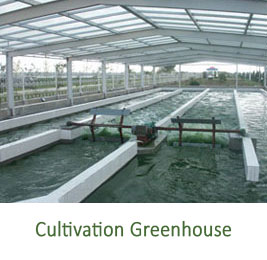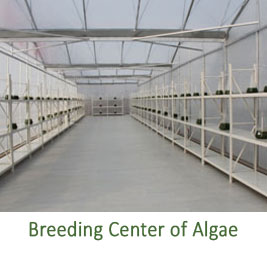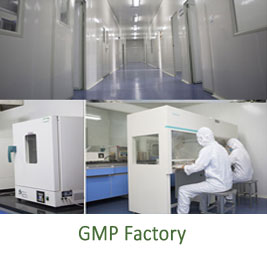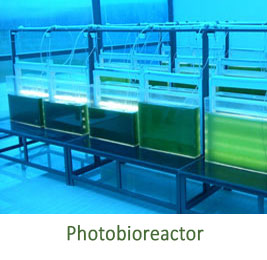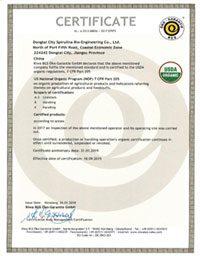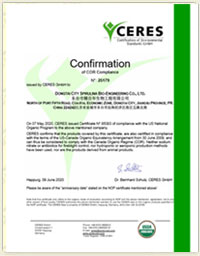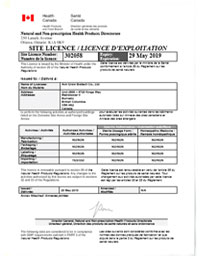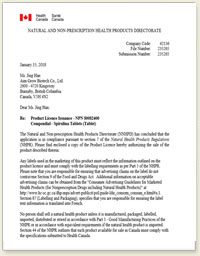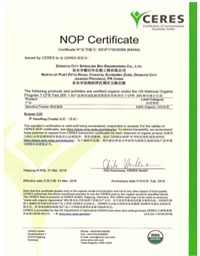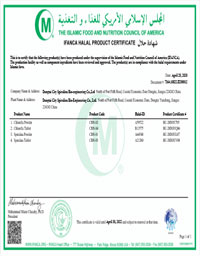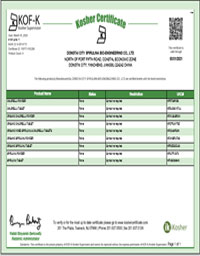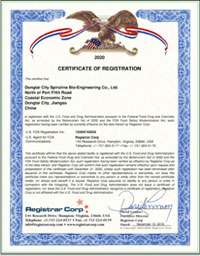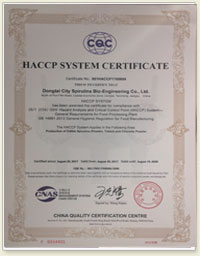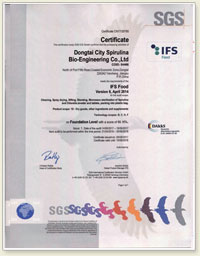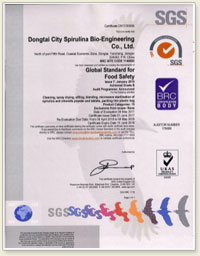Spirulina
What is Spirulina
Spirulina is 100% natural and a highly nutritious micro salt water plant. It is a blue-green algae that is cultivated worldwide as a food source. It was discovered in South American and Africa in natural alkaline lakes. For a long time (centuries) this algae has constituted a significant part of the diet of many communities. Since the 1970's, Spirulina has been well known and widely used as a dietary supplement in some countries.
Spirulina Nutrition
Spirulina contains rich vegetable protein (60~ 70 %, 3~4 times higher than fish or beef ), multi Vitamins (Vitamin B 12 is 3~4 times higher than animal liver), which is particularly lacking in a vegetarian diet. It contains a wide range of minerals (including Iron, Potassium, Magnesium Sodium, Phosphorus, Calcium etc.), a high volume of Beta- carotene which protects cells (5 time more than carrots, 40 time more than spinach), high volumes of gamma-Linolein acid (which can reduce cholesterol and prevent heart disease).
Spirulina Benefits for Animals
* Spirulina enhances the immune system; * Spirulina improve gastrointestinal health * Spirulina improve heaves/COPD/ Asthma * Spirulina improve seasonal respiratory allergies * Spirulina improve hives and other skin allergies * Spirulina improve Sweet Itch (Summer Eczema)
About Us

Who we are
Aimgrow Biotech is a British Columbia, Canada based biotechnology company, also has marketing branch in Tokyo, Japan. Aimgrow is committed to providing microalgae and their extractions that brings health to people’s everyday lives. We have built a strategic partnership with microalgae professional organizations all over the world.
Our Manufacture
Our manufacture is one of the largest Spirulina and Chlorella manufacturers and suppliers in the world. Today, it has 5 cultivation farms, one R&D centre, one GMP plant. Our Spirulina products are ecologically grown for 100% purity and safety with hundred of international certificates and supplied over 20 countries and regions world-wide, such as Japan, North America and Europe.
Spirulina Resources
Spirulina as a livestock supplement and animal feed
Summary
Spirulina is an edible microalga and a highly nutritious potential feed resource for many agriculturally important animal species. Research findings have associated Spirulina to improvements in animal growth, fertility, aesthetic and nutritional product quality. Spirulina intake has also been linked to an improvement in animal health and welfare. Its influence over animal development stems from its nutritive and protein‐rich composition, thus leading to an increased commercial production to meet consumer demand. Consequently, Spirulina is emerging as a cost‐effective means of improving animal productivity for a sustainable and viable food security future. However, our present knowledge of animal response to dietary Spirulina supplementation is relatively scanty and largely unknown. Therefore, the primary objective of this paper was to review past and current findings on the utilisation of Spirulina as a feed supplement and its impact on animal productivity and health. Only animals deemed to be of agricultural significance were investigated; hence, only ruminants, poultry, swine and rabbits and their responses to dietary Spirulina supplementation are covered.
Introduction
Demand for animal products is increasing because of global changes in consumer tastes and expanding markets, particularly in developing countries where affluence is spreading. However, two key obstacles must be overcome before this projected demand can be met:
-
(i) increased competition for land, with urban sprawl, biofuel production and other agricultural applications taking up land otherwise used for animal production, and
(ii) climate change negatively affecting water and animal feed availability in current production regions.
The identification of new feed resources is therefore crucial for sustainable animal production and future viability. Ideally, the new feed resource should have high nutritive value and conversion efficiency, be able to optimise animal product quality and use land and water efficiently. Consequently, Spirulina is emerging as a potential candidate to meet these criteria. Feeding trials with Spirulina have been conducted in chickens, pigs, ruminants and rabbits. The main objectives of this paper were to review the nutrient composition of Spirulina, integrate research findings from the feeding trials and highlight the effect of dietary Spirulina supplementation on animal health and productivity.
Historical background of Spirulina
Spirulina is an edible, filamentous, spiral‐shaped cyanobacterium, formally classified as a blue‐green microalga. It is naturally found in the alkaline lakes of Mexico and Africa, where it has a long history as a food source for their ancient human inhabitants. Spirulina was ‘rediscovered’ relatively recently by Leonard and Compere in the 1960s and has since become a mass produced product. Presently, Spirulina is commercially produced worldwide and is used as a nutritional supplement for both humans and animals, with approximately half of the total Spirulina production being used in livestock and fish feeds.
Spirulina is produced commercially within a nutrient‐rich, liquid medium; hence, it can be produced with high land‐use efficiency. For instance, Spirulina outyields many other traditional animal feed types, including wheat, corn, barley and soybeans, in protein output per land unit. Furthermore, Spirulina can be actively produced using desalinated waste water (Volkmann et al., 2008) and animal faecal wastes to enrich the growth medium. This has been reported in pig (Chaiklahan et al., 2010) and cattle faecal wastes with clearly consistent results demonstrating that Spirulina is safe to be fed back to livestock. These processes are described in detail by Hasdai and Ben Ghedalia (1981) and Chaiklahan et al. (2010). Nonetheless, this highlights Spirulina’s capacity to cost‐effectively treat wastes and recycle otherwise lost nutrients.
Currently, Spirulina is relatively expensive to produce and purchase compared to other animal feeds. This makes its use impractical in many large‐scale animal production operations. Additionally, Spirulina’s palatability, dried powdery form and smell all limit its use in animal production (Becker, 2007). However, Spirulina’s production cost can be lowered with developments in low‐cost growth media and an improvement in the operational management of Spirulina’s nutrient‐use efficiency and growth rate. Furthermore, research into Spirulina delivery methods and its impact on product quality is increasingly allowing us a greater understanding of the practicalities of its use.
What is Spirulina?
Spirulina (Arthrospira platensis) is a blue-green algae that is cultivated worldwide as a food source. It has a spiral shape to it and is approximately 3.6 billion years old. What is so wonderful about natural horse spirulina is that it is a natural source of:
- Protein: 55-70%
- Vitamins and Nutrients: vitamin A, B1 (thiamine), B2 (riboflavin), B3 (niacin), B6 (pyridoxine), B12 (cobalamin), vitamin C, vitamin D, vitamin E, folate, vitamin K, biotin, pantothenic acid, beta carotene (source of vitamin A), and inositol
- Minerals: calcium, manganese, iron, chromium, phosphorus, molybdenum, iodine, chloride, magnesium, sodium, zinc, potassium, selenium, germanium, copper, and boron
- Amino Acids: isoleucine, phenylalanine, leucine, threonine, lysine, tryptophan, methionine, valine, alanine, glycine, arginine, histidine, aspartic acid, proline, cystine, serine, glutamic acid, and tyrosine
Horses
Spirulina for horses is a blue green alga which is well documented for maintenance of a healthy immune system to provide a nutritional support for healthy skin and help to maintain normal immune system response to challenges from fly and midge bites. This product is also very useful in helping maintain healthy lungs in response to challenges from environmental influences like dust and mould spores.
It’s a blue-green algae superfood that is useful for a variety of equine (as well as human and other animal) conditions. Named for its unique, spiral shape, Spirulina has been around for about 3.6 billion years.
Spirulina is probably best known for its ability to boost the immune system. It is high in protein (55-70%), vitamins, minerals, and amino acids. According to Dr. Kellon, it’s been shown “to specifically improve the production of IgG antibodies, while down-regulating allergies associated with IgA antibody responses.” (IgG and IgA antibodies are two of the five types of pathogen-fighting antibodies found in mammals.)
The health benefits of Spirulina are many–and are backed by mainstream research. Here are a few equine conditions that Spirulina supplementation can be beneficial for:
- Heaves/ COPD/ Asthma
- Seasonal respiratory allergies
- Hives and other skin allergies
- Sweet Itch (Summer Eczema)
- Poor immune function
What are some other benefits of feeding Spirulina?
- It can help increase a horse's appetite.
- It can help horses relieve allergies such as hives.
- It can help horses with breathing problems such as heaves (also known as COPD).
- In addition to helping a horse's physical body, spirulina has been known to help the mental aspect of a horse by relieving anxiety and improving their attitude and training ability.
How to feed Spirulina to your horses?
Spirulina powder is dark green and has a silky texture. It’s not the most palatable of supplements, but you can mix it in your feed to get your horse to eat it. It works well by being mixed in a few cups of Beet Pulp with some chopped carrots and some of your horses’ favorite grain. If he won’t eat it in the feed, you can try mixing it in honey, applesauce, or distilled water and syringing it in his mouth.
The recommended dose for Spirulina powder is 20 grams (1 oz) twice per day. It may take up to four weeks to see results with Spirulina, so be patient and stick with it!
One tablespoon of powder = 7.38 grams
Therefore: 2.7 tablespoons = 20 grams.
Therefore 40 grams = 5.42 tablespoons
If your horse suffers from seasonal allergies every year, you will want to start him on Spirulina about a month before the symptoms tend to show up.
Nutritional value of Spirulina
Spirulina is nutrient rich. It contains all essential amino acids, vitamins and minerals. It also is a rich source of carotenoids and fatty acids, especially γ‐linolenic acid (GLA) that infers health benefits. However, Spirulina’s high protein content distinguishes it as a new animal feed.
Chickens
Chickens have been almost the exclusive focus of research into Spirulina’s usefulness in monogastric feed rations. Ross and Dominy (1990) found that chicken growth rates declined when Spirulina replaced dehulled soybean meal in rations at either 10% or 20% of dry matter. Other studies that replaced groundnut cake or fishmeal with Spirulina in chicken diets found no variation in growth. Therefore, from these studies, it is apparent that the impact of dietary inclusion of Spirulina on chicken growth and growth rates depends on the feed type it replaces in the ration. Although it has been shown that dietary Spirulina levels of 50–100g/kg of feed ration will maintain typical growth rates, levels exceeding 200g/kg will bring about declined growth rates.
Growth
- Growth rates declined in 3‐week‐old chicks fed Spirulina levels of 10% and 20% of diet;
- Body weights of chicks fed Spirulina levels of 11.1% and 16.6% of diet were not different from the control group, receiving groundnut cake;
- Broilers fed Spirulina levels of 140 and 170g/kg of diet and vitamin and mineral premixes omitted had no difference in dressing percentage compared to those receiving fishmeal or groundnut cake;
- Broilers fed Spirulina levels of 0, 40 or 80g/kg of diet for 16 days did not significantly differ in body weights;
- Broilers fed Spirulina levels of 40g/kg of diet had greater muscle redness and yellowness than the control group;
- White Leghorn and broilers fed Spirulina levels of 0, 0.001, 0.1, 1 and 10g/kg of diet had comparable body weights after 7 weeks
Health
Chicks fed Spirulina levels of 10g/kg of diet had increased NK cell activity compared to the control group, showing an enhanced disease resistance potential
Chicken phagocytic activity had an incremental linear increase with increasing dietary Spirulina levels of 0.5%, 1% and 2% of diet
Product quality
- White Leghorn hens’egg total cholesterol levels were reduced when diets contained 150g flaxseeds+200mg vitamin E+3g Spirulina per kg diet
- White Leghorn layers, aged 32 weeks, fed 20% whole flaxseeds and 5% Spirulina (w/w) produced eggs with higher levels of linoleic acid with less cholesterol
- Egg yolk colour score was higher in layers fed flaxseed diets with 5% Spirulina (w/w) compared to those on a flaxseed diet (20% w/w)
- Optimal egg yolk pigmentation was obtained by feeding Spirulina levels of 1% of diet, when diet is otherwise free of xanthophylls
- Egg yolk carotenoids pigment and omega‐3 fatty acid levels increase when White Leghorn hens fed 150g flaxseeds+200mg vitamin E+3g Spirulina per kg diet
Dietary Spirulina has been associated with greater cost‐efficiency in chicken production. Venkataraman et al. found that vitamin–mineral premixes normally added to chicken feed rations can be omitted when Spirulina is included, owing to its nutrient‐rich composition. Furthermore, chickens receiving dietary Spirulina have been found to be of better health than their unsupplemented counterparts (Venkataraman et al., 1994). This is attributable to increased functionality of macrophage and overall mononuclear phagocyte system indicative of enhanced disease resistance with increased dietary Spirulina levels in chickens (Qureshi et al., 1996; Al‐Batshan et al., 2001). Qureshi et al. (1996) found improved chicken health with low dietary Spirulina levels of 10 g/kg in the ration, indicating greater production cost‐efficiency.
Spirulina has been shown to be an effective means of altering chicken product quality to meet consumer preferences. For instance, the total cholesterol content of eggs can be lowered by including Spirulina into layer hen rations (Sujatha and Narahari, 2011). This is mainly attributable to Spirulina’s high antioxidant and omega‐3 polyunsaturated fatty acid (PUFA) content that enriches the nutritional value of eggs at the expense of cholesterol content (Rajesha et al., 2011; Sujatha and Narahari, 2011). Egg yolk colour has also been found to intensify linearly with increased dietary Spirulina levels (Ross and Dominy, 1990; Sujatha and Narahari, 2011). In White Leghorn layer hens, dietary Spirulina levels of 3–9% of the total ration were found to result in egg yolk colours best representative of consumer preferences (Saxena et al., 1983). Similar findings have been found in trials with Japanese quails (Ross et al., 1994). Spirulina’s effect on yolk colour results from its high level content of zeaxanthin, xanthophylls and other carotenoid pigments, particularly β‐carotene, which accumulate within the yolk. These same compounds have been found to also accumulate within the muscle tissue of chickens. Both Toyomizu et al. (2001) and Venkataraman et al. (1994) have reported this outcome with muscle tissue increasing in yellowness and redness with increasing levels of dietary Spirulina. Dietary Spirulina levels at 1% of the total ration in the week prior to slaughter have been found to result in broiler muscle tissue pigmentation at levels best representing consumer preferences.
Pigs
Research into pig growth responses to dietary Spirulina supplementation is inconsistent as depicted. It found that crossbred weanling pigs receiving dietary Spirulina supplementation had growth rates of up to 9% higher than their unsupplemented peers. However, Grinstead et al. (1998) found no growth difference between Spirulina‐supplemented and unsupplemented pigs. This contrasting finding is attributable to differences in experimental procedures.
Growth
- Crossbred weanling pigs fed Spirulina levels of 1.5% and 3% of diet had higher growth rates compared to the control group
- Weanling pigs fed Spirulina pelleted diets had decreased average daily gain (ADG), while those receiving Spirulina in meal diets had improved ADG
- ADG in pigs fed Spirulina levels of 2% of diet was greater than in the control group, during days 14–28 post‐weaning
- Pigs fed Spirulina levels of 14% of diet had similar growth as those fed skim milk powder
- Increasing Spirulina levels in pig diets (0.5%, 1% and 2% diet) showed only a numerical increase in ADG
Fertility
Boars fed BioR (extracted from Spirulina) at 1.5ml/day had increased ejaculate volume and spermatozoa mobility compared to a control group
Different pig genotypes were used by Hugh et al. (1985) and Grinstead et al. (1998). The influence of heterosis in the crossbreds potentially affected the observed growth. Another explanation was that dietary protein digestibility decreased with increasing levels of Spirulina in pigs partly due to Spirulina’s complex cell wall structure being able to withstand the pig’s digestive enzymes. Furthermore, differences in the basal diets of the pigs would affect any growth response, as much as the form in which the dietary Spirulina was provided. For instance, a difference in the growth was shown between pigs fed pelletised and non‐pelletised Spirulina. Pig health has also been suggested as a causal factor of the different outcomes in growth trials with Spirulina. Also, Spirulina’s usefulness in pig feeds will depend on the feed type it is replacing. For instance, Spirulina has been demonstrated to be a viable replacement for dried skim milk powder in pig feed rations.
Pig rations containing Spirulina have been linked to improved boar fertility. Granaci found that boars receiving a Spirulina extract had greater overall sperm quality than their unsupplemented counterparts in terms of increased sperm volume by 11% and motility and post‐storage viability by 5%.
Ruminants
The ability of ruminants to digest unprocessed algal material makes them especially suited to dietary Spirulina utilisation. This is further complemented by an efficient digestion of Spirulina’s carbohydrate fraction by ruminants when used in levels up to 20% of total feed intake, compared to other algal feed types like Chlorella or Scenedesmus obliquus. Spirulina has been shown to increase microbial crude protein production and to reduce its retention time within the rumen. Furthermore, approximately 20% of dietary Spirulina bypasses rumen degradation and is therefore available for direct absorption within the abomasum.
When Spirulina is delivered to ruminants as a water suspension, it has been found to be preferentially consumed compared to pure water. Moreover, Spirulina’s high sodium content increases water consumption and urine excretion in ruminants, although this is generally typical of algal feed types.
Cattle
Spirulina trials using dairy cows have produced positive results with direct impact on productivity. found that cows receiving dietary Spirulina had a 21% increase in their milk production. Furthermore, It showed an increase in milk fat, milk protein (up by 9.7%) and lactose (up by 11.7%) in cows receiving Spirulina compared to those receiving no Spirulina. The saturated fatty acid content of milk decreased and monounsaturated fatty acidss and PUFAs increased when cows received Spirulina. These results could be attributable to Spirulina’s influence on microbial protein synthesis, avoidance of rumen degradation and its nutrient‐rich composition. Moreover, these findings highlight Spirulina’s use in enhancing milk’s health appeal.
Growth
Dairy cows fed 200g Spirulina daily were 8.5–11% fatter than the control group, evaluated using body condition score;
Productivity
Dairy cows fed 200g Spirulina daily produced more milk than the control group; Cows fed Spirulina levels of 2g/day (w/w) produced more milk than the control group; Spirulina levels of 0.15% of diet resulted in decreased rumen degradability of dietary crude protein;
Product quality
- Milk from cows fed Spirulina levels of 2g/day had greater average milk fat, protein and lactose than controls;
- Milk saturated fatty acid levels decreased, while mono‐ and polyunsaturated fatty acids increased when crossbred Holsteins were fed Spirulina at 40 g/day; Spirulina fed at 2g/day to dairy cows reduces the somatic cell counts;
Sheep
Growth
- 6monthold lambs fed Spirulina levels of 10% (w/w) had greater liveweights than those given 20% (w/w) and the control group;
- Lambs body condition scores incrementally higher in lambs fed Spirulina levels of 10% and 20% (w/w) compared to controls;
- Lambs fed cow milk enriched with 10 g/day Spirulina had higher liveweights and growth rates during 15–30 days old than the control group;
- Pregnant ewes fed pellets containing 2 g Spirulina ad libitum produced newborn lambs with higher weights and average daily gains than those from control treatment ewes;
- Dietary Spirulina has also been associated with significant decreases in milk somatic cell count, thus improving milk’s food safety value. Additionally, dairy cows receiving Spirulina have been found to have improved body condition (8.5–11%) when compared to others receiving no Spirulina.
- As with pigs, bull sperm quality has been shown to be improved with Spirulina. Sperm motility, concentration and post‐storage viability were all positively affected when bulls received a bio‐extract removed from Spirulina. However, the effect of ‘raw’ dietary Spirulina on bull sperm quality needs to be further studied.
Research into sheep production responses to dietary Spirulina is in its infancy. Nonetheless, Bezerra et al. (2010) found that lambs receiving Spirulina have higher liveweights and average daily gains (ADG) than other lambs receiving no Spirulina. Findings from Holman et al. (2012) also show an increase in lamb liveweight with dietary Spirulina along with an increase in body condition and other body conformation traits. However, variation in ADG did not reach statistical significance. This divergence between the two studies was mainly because of age differences of the lambs and Spirulina suspensions in water used to deliver the Spirulina.
Shimkiene et al. (2010) have shown that pregnant ewes receiving Spirulina deliver heavier lambs (up 4.07%) with greater ADG compared to pregnant ewes receiving no Spirulina.
Rabbits
Spirulina has been trialled in the feed rations of commercially farmed meat rabbits. Its inclusion in rabbit diets has been shown not to influence rabbit growth (Peiretti and Meineri, 2008) or carcass yields (Peiretti and Meineri, 2011). These findings may quell concerns that feed rations containing Spirulina would be less digestible than conventional rabbit diets. However, rabbits receiving dietary Spirulina have an increased total feed consumption compared to those receiving no Spirulina (Peiretti and Meineri, 2008). Dietary Spirulina levels of 1% of total dry matter were found to improve crude protein digestibility in rabbits fed both low‐ and high‐fat diets compared to those receiving no Spirulina (Peiretti and Meineri, 2009). Hence, including Spirulina into rabbit diets may be useful when basal diets are high in fat to provide sufficient energy to ‘fuel’ optimal growth rates (Peiretti and Meineri, 2009).
Growth
- Final weight and weight gain did not differ between rabbits fed Spirulina levels of 0%, 5%, 10% or 15% of diet
- Feed intake of rabbits fed Spirulina levels of 5% and 10% of diet was greater than the control and 15% groups
- Rabbits receiving Spirulina levels of 1% of diet had increased crude protein digestibility in both low‐ and high‐fat diets
- Spirulina levels of 10% of diet resulted in high feed intake compared to control group
Health
New Zealand White rabbits fed a high‐fat diet and supplemented Spirulina levels of 10 g/kg of diet had reduced reactive oxygen species and oxidative stress
Product quality
Linoleic acid content in the perirenal fat and meat tissue in rabbits increased with Spirulina levels of 5%, 10% and 15% of diet
Rabbit meat quality has been shown to improve when rabbits received dietary Spirulina. For instance, Meineri et al. (2009) and Peiretti and Meineri (2011) both identified dietary Spirulina as a causal factor for increasing GLA and n‐6/n‐3 PUFA ratios within rabbit muscle lipid contents. This supports continued consumer‐preferable meat colour and appearance by improving rabbit meat’s oxidative stability (Dalle Zotte and Szendro, 2011). Furthermore, GLA has health benefits for humans (Howe et al., 2006), and its increased level in rabbit meat would appeal to health‐conscious consumers. Rabbit health has also been found to improve with dietary Spirulina, as rabbits receiving Spirulina had greater oxyhaemoglobin levels than those receiving no Spirulina (Meineri et al., 2009).
Conclusion
Spirulina is a promising new feed resource to support future animal production needs. Trials using dietary Spirulina in feed rations of many agriculturally significant animal species have already shown improvements in productivity, health and product quality. However, many results contradict other findings and together present an inconsistent trend of Spirulina’s usefulness as an animal feed. Therefore, further research with Spirulina in beef cattle, sheep, goats, llama, alpaca and deer is needed to clarify its potential. Furthermore, investigations into Spirulina’s active ingredients and associated biological pathways would aid in broadening our knowledge, scope and applicable ramifications in sustainable animal production into the foreseeable future.
Acknowledgements
The senior author of this paper was funded by research grants and PhD scholarships from the University of Tasmania (UTAS), the Australian Wool Education Trust (AWET) and the Commonwealth Scientific and Industrial Research Organisation (CSIRO) Food Futures National Flagship. We are grateful to these organisations.
Reference from Wiley Online Library
Certifications
Our company has currently obtained Canadian Organic Regime(COR), Unite State Organic Certificate, BV Certificate, KOSHER Certificate, Idanca Halal Product Certificate, NOP Certificate, U.S. FDA Certificate,ISO9001 Food Management System Certificate, ISO22000 Quality Safety System Certificate, etc.
Contact Us
Please feel free to contact us if you have any questions.
Office Hours: Monday to Friday: 10 am - 5 pm
Location:
#64-1833 Coast Meridian Road
Port Coquitlam, British Columbia V3C 6G5 Canada
Email:
info@aimgrow.com
Call:
1-800-618-6199
We will call you back during regular business hours, please leave a voice message with your name and number.

